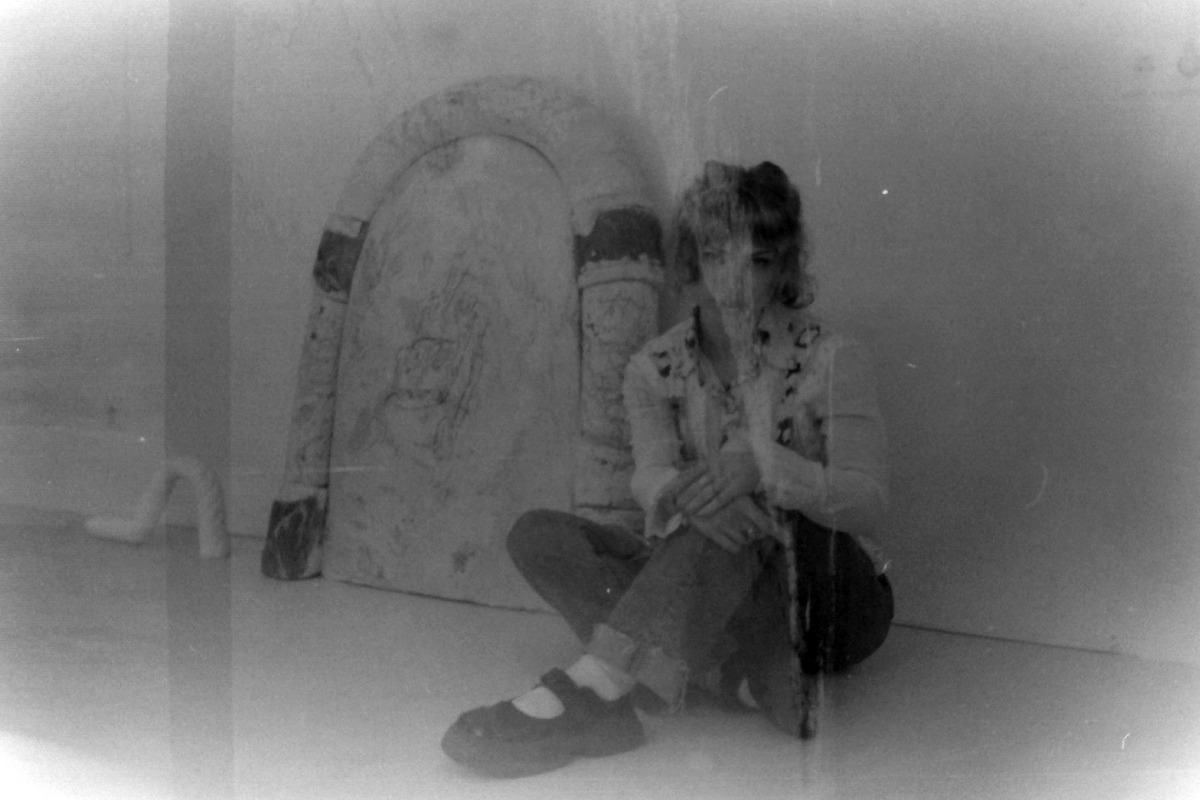
Doom Doom Delight
Viktoria Weber, TUR_telpa
An interview with artist Dzelde Mierkalne about her upcoming exhibition at TUR_telpa
An interview with artist Dzelde Mierkalne about her upcoming exhibition at TUR_telpa and her visual vocabulary that draws from amusement parks as well as burial sites to depict the contemporary struggles of living with an uncertain future. In an imaginary landscape of fake grass, fake marble and fake candles fiction and reality merge into an alienated, parallel world. While in amusement parks as Disneyland bleakness bursts through the cracks of a shiny plastic superficiality, Mierkalne draws a world that doesn’t negate our harsh realities, but instead emphasizes the fragility and transience of life. ‘Doom Doom Delight’ opens on April 4th at TUR_telpa, Riga.
Viktoria Weber: Before you studied POST at the Art Academy in Riga, you studied graphic art. Naturally, I was wondering why you decided to leave the flat surface. How did you start to integrate different artistic expressions into your work?
Dzelde Mierkalne: I really enjoyed graphic art and I love putting my hands to work through various techniques, especially mezzotint. That was what I made for my final work during my bachelor’s. During my last year, I really started to think about my flat, graphic works in some kind of space, and when I started to think about the last series I made when I was studying there, I quite naturally saw the graphic work in a spatial setting. Even though there are so many ways to do graphic art, I don’t want to just put paper on a wall. I want to frame it through the space, and that's when I started mixing it with other techniques, even though I didn't have much skill regarding sculpture. I just went with my gut. I started with a sketch before making it in real life. When I am making it, working it, I get this feeling of, wow, I love this. I love to shape it into a form while keeping a drawing element and putting it in a 3D setting. I love to make it more playful and almost touchable, yes, just in this sense of something real, like in the world out there. Also, I perceive my current work still as a drawing because it contains these inlay drawings I create as well as the natural patterns that are showing up through the scagliola process.
It’s quite interesting as you work with scagliola, a material that imitates marble. Especially marble is one of these materials people love to touch but often aren’t allowed to. Just think about ancient marble statues in renowned museums, and the buildings themselves often consist of the same material. The fact that you work with scagliola is quite interesting, as it’s not a common material. How did you start to incorporate this technique into your practice?
Well, it was during my time at POST, right after I finished my Bachelor in Graphic Art. I didn’t have access to the graphic workshop anymore, and as much as I loved keeping my hands busy there, I needed to explore forms. So I started my first experiments with basic plaster, but I wasn’t enjoying the results. Plaster itself just still feels kind of flat to me, yes, it was mostly thanks to my teacher, Armands Zelčs, who told me that if I’m interested in working with plaster, I should look into the technique of scagliola. The thing is that there weren't any Masters I could ask about the process so I researched it online, even Google translating some Italian sources as it is an Italian technique. There's not much information about it, but it was enough for the first steps. When I started making it, I was mixing information I gathered online. I just wanted to elevate the form, as plaster wasn't giving me the freedom and the finished results I wanted. When experimenting with the scagliola technique, there was a wow, I can do this with my hands, moment. At first, I just made basic ones, but then I understood how the technique gives the freedom to experiment with the form. Like with plaster, you basically pour it, it’s quite liquid as you work with it because it hardens very fast due to the water. But scagliola is plaster mixed with animal glue, so it becomes more mouldable, takes on shapes. There’s a period of time when I can still form it. With normal plaster, you have a good idea of what the result will be like, but with scagliola, it surprises you. In this way, it’s similar to graphic art. When you’re doing prints, you only really know the result when you lift up the paper. Scagliola contains this mixture of pigments, and even if I know the colours I use, it creates patterns very uncontrollably. During the process, there’s a point when it looks like nothing, just like a grey cloud of something, and after a few days it dries, I can take my tools to scrape the top part off. That’s when the pattern comes out, and I see what I’m working with. I really love this surprise, it feels like opening gifts on Christmas.
It sounds like you have to be able to trust the process and let go when working with scagliola.
There’s always a moment in the process that feels like, what am I doing? Because it's dirty, dusty, and you’re just working with these wet slabs of something. Then it turns out that I did make something worthwhile, but I love that.
You use scagliola as a material and technique that imitates marble, and in your upcoming show in TUR_telpa, which opens on the 4th of April, you’ll be involving elements of fake grass. You also work with fake candles. Within your artistic practice, there are elements that imitate our reality. How do these materials resonate with the topics of your practice?
I think there’s a certain level of playfulness to it, because not everybody knows it’s not real marble. It’s not always my goal for it to look like marble. At the end of the day, it's mostly a technique that I use to my advantage. The scagliola technique is an imitation technique through which, with a certain skill level, you could imitate any kind of stone based on pigments and patterns. But yes, it resembles this feeling in Disneyland, with all its castles and decorations that feel almost real. But it’s a fairy tale; it gives you a fantasy. The goal is the feeling of fantasy; it’s not really important that it’s not a real candle. It doesn’t have to be real; it’s art.
‘LOWKEY KATASTROFY FUNRIDE’, 2023, photo by the artist
‘LOWKEY KATASTROFY FUNRIDE’, exhibition view in ‘Breaststroke, Backstroke and Butterfly’ POST graduation work exhibition in Riga, 2023, photo by Līga Spunde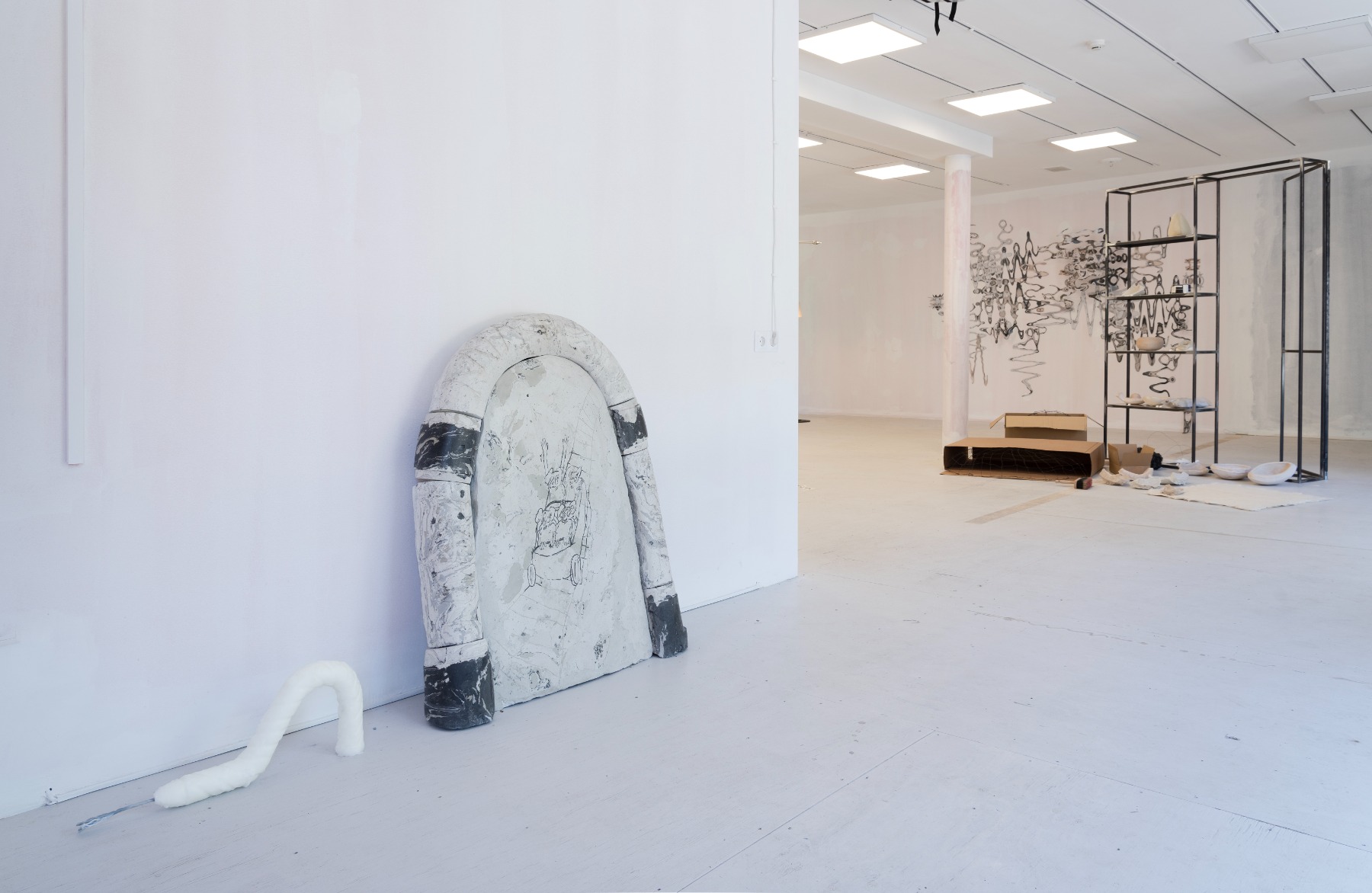
Disneyland seems to be a keyword in your recent work. At your graduation show of POST, you showed ‘LOWKEY KATASTROFY FUNRIDE’. So, you draw a connection between mortality and amusement within our culture. How do you understand this relationship?
Well, I think that in this time and place, at least in my generation, there is a certain sense of impending doom. There’s a certain sense that things are going south and an uncertainty about what to do with it. Sure, you can be positive and active, but you have to be aware of what's happening not only in your yard but also in your neighbour’s yard. Not everything is as stable as it would be nice to be, but it gives this certain sense of, well, what can I do with it? I guess I just have to enjoy it and have fun. There’s a certain sense of absurdity in being super positive about things while knowing that things aren’t that good. I am interested in reflecting on how we are living day to day. Nobody can tell you to not have fun because things are bad, but most people are aware of how things are in the world. There is a certain sense of anxiety about how things will be in a few years. But in the end, people will always want to go to Disneyland to enjoy the ride. Even though there is an absurdity in that, it’s just a few hours of fun before going back to the office. Well, there's nothing I want to teach people; it’s my reflection on the state of the world.
I can definitely resonate with what you’re describing, maybe because we are of the same generation. I personally feel like the last few years have made these contrasts even more obvious. With the COVID-19 pandemic and then with one war starting after another, the inescapability of a doomed future becomes very present. I can observe with myself, but also in people around me, that with the realisation that we probably won’t be able to save this planet, there’s a rise of a rather hedonistic way of living.
Yes, it doesn’t mean that we have to completely give up and be depressed about it. There must be a balance between this feeling of doom and the ability to enjoy life.
Through your work, you make people conscious of this relationship; you directly bring them into contact with topics like mortality and our doomed future. Would you call yourself a pessimist?
Not at all. I definitely lean towards a more optimistic side, but it’s hard to tell because when I meet fully optimistic people, like well, have you heard what's going on? I would never want to call myself a cynic or a pessimist because, even when things are getting bad, I want to believe we might pull through somehow. Who knows? It’s uncertainty, not pessimism.
‘END IS NIGH!’, 2021, exhibition view in DOM gallery, Riga, photo by the artist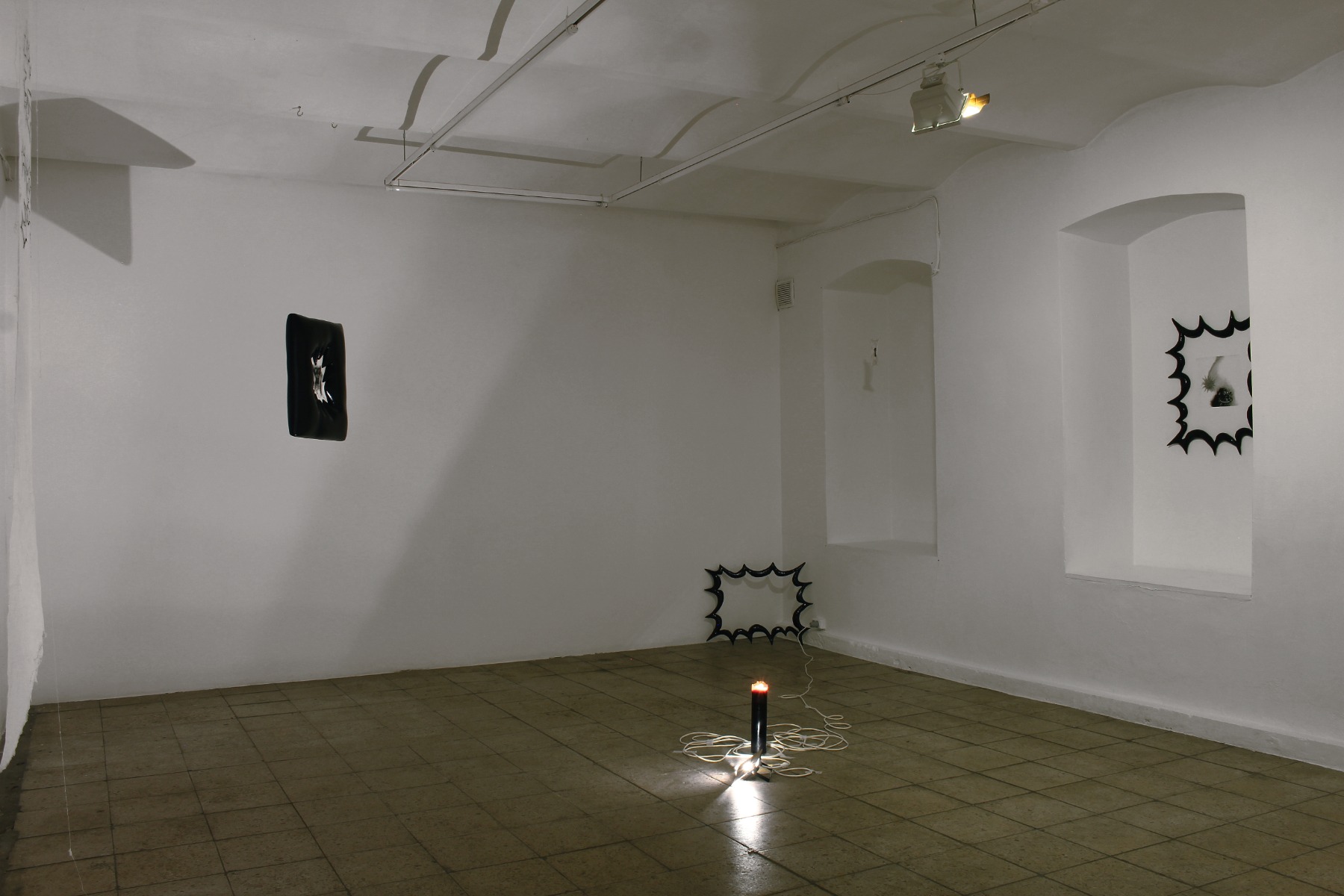
You had your first solo exhibition in DOM gallery in 2021, which is a very different space from TUR_telpa. TUR is very specific and also much bigger. How do you want to use the space?
Well, I want to use this feeling of spaciousness that comes with the high ceiling. I can use that to my advantage and make some objects bigger. I am trying to create an imaginary landscape, a fantasy world. It reminds you that time is ending, but in a way, time is also stopped with those candles. With the scagliola works, I am trying to achieve a sense of time long forgotten or standing still. Even if it’s not real stone, it gives the fantasy of something eternal. This fantasy world makes you reflect on time being lost. There’s also this sense of playing around. It’s hard to grasp the words without seeing it in the space.
In a way, it resembles a future archaeology of past lives, but at the same time, by your choice of material, like fake marble and fake grass, these materials actually wouldn’t last; even plastic decays at some point.
In a way, it clashes because of course, they wouldn’t last; they aren’t real. But also, because it’s fake, it may last even longer than the real materials, especially when we’re talking about grass. Sometimes, to make something alive forever, it has to be dead. The fake grass is something I got inspired to use when walking around Latvian cemeteries. It was a bit amusing; there were these grave sites that usually have some kind of flower or forest green on top of them. But on those graves, quite a lot of people were using just a slab of fake grass, which feels a bit ridiculous when you look at this cemetery in a beautiful forest. People can’t go every week to the cemetery to check up on the flowers, clean up, so it feels better to just put fake grass. It looks greener throughout the year, but most of the grass is paled out due to the sun. Especially together with the fake flowers, it gives such a weird feeling that feels incorrect.
I had a similar experience recently when visiting a cemetery in Vilnius. It was astonishing how you had these very old graves, some made of marble. Many stones were broken or destroyed, and it visualised how time has passed, but on top there are these bright or even neon coloured fake flowers. Cemeteries are interesting places as they reflect how culturally our relationship to death changes all the time. People used to visit these sites frequently, but with life moving so fast, people spend less time connecting with past generations.
I remember in my childhood, it was really every week that my grandmother would freshen up the gravesite of our family. It was such a daunting task as a kid, but not because it's a cemetery. Now that I have grown up, together with many people who have also grown up from that, it’s definitely not the culture anymore. The fake flowers and fake grass; it shows that you want something nice to be there, even if it's fake. After all, cemeteries are for the living, not the dead. Even if you can’t go often, you feel like there should be flowers. It might as well be fake, so it doesn’t die. It still shows some form of caretaking.
Also, in cemeteries, there tends to be a place to sit, both for practical reasons when you go to freshen up the space, you might need to sit down. But it also feels like this imaginary place for the deceased to sit down so they can chill on the side. In the show, there will be this bench that you cannot sit on; it just says ‘HAHA’. These similarities to cemeteries become visual media to reflect on this certain atmosphere, which we can relate to even if you have no emotional connections to the specific place. You know that for somebody, it might be something emotional, but for you it’s just visual material.
Something else that is part of your practice as well as the upcoming show are the dust drawings.
I create these works called ‘Settledust’ made out of the scagliola dust that I gather when making the stones. I’m drawing on the ground using only the dust. So, it’s a bit similar to the Buddhist mandalas they make, only to be wiped down in order to teach you how you shouldn’t get too attached to things. Those drawings are something I enjoy in relation to scagliola because the material embodies this sense of foreverness. The dust drawing is so temporary and so ephemeral. I really love the juxtaposition between something that holds this foreverness and something that is so fragile and can get lost. It works very differently in each space, which is kind of magical. Also, I expect that it will be ruined at some point, but yes, when the dust settles, that’s when you usually find some clarity. But in my art, it’s exactly the opposite because the dust never settles; everything just keeps bringing it up, and you never get this real sense of clarity. In a way, the marbles are just dust collected. Then there’s also this saying about dust - from dust we come to dust we go - so that's also something in my mind. I’m thinking a lot about the material itself because it holds a certain sense of thoughtfulness.
‘Settledust (sculpture)’, 2022, exhibition view in ‘Sardines’ in Garage Gallery, Prague, photo by the artist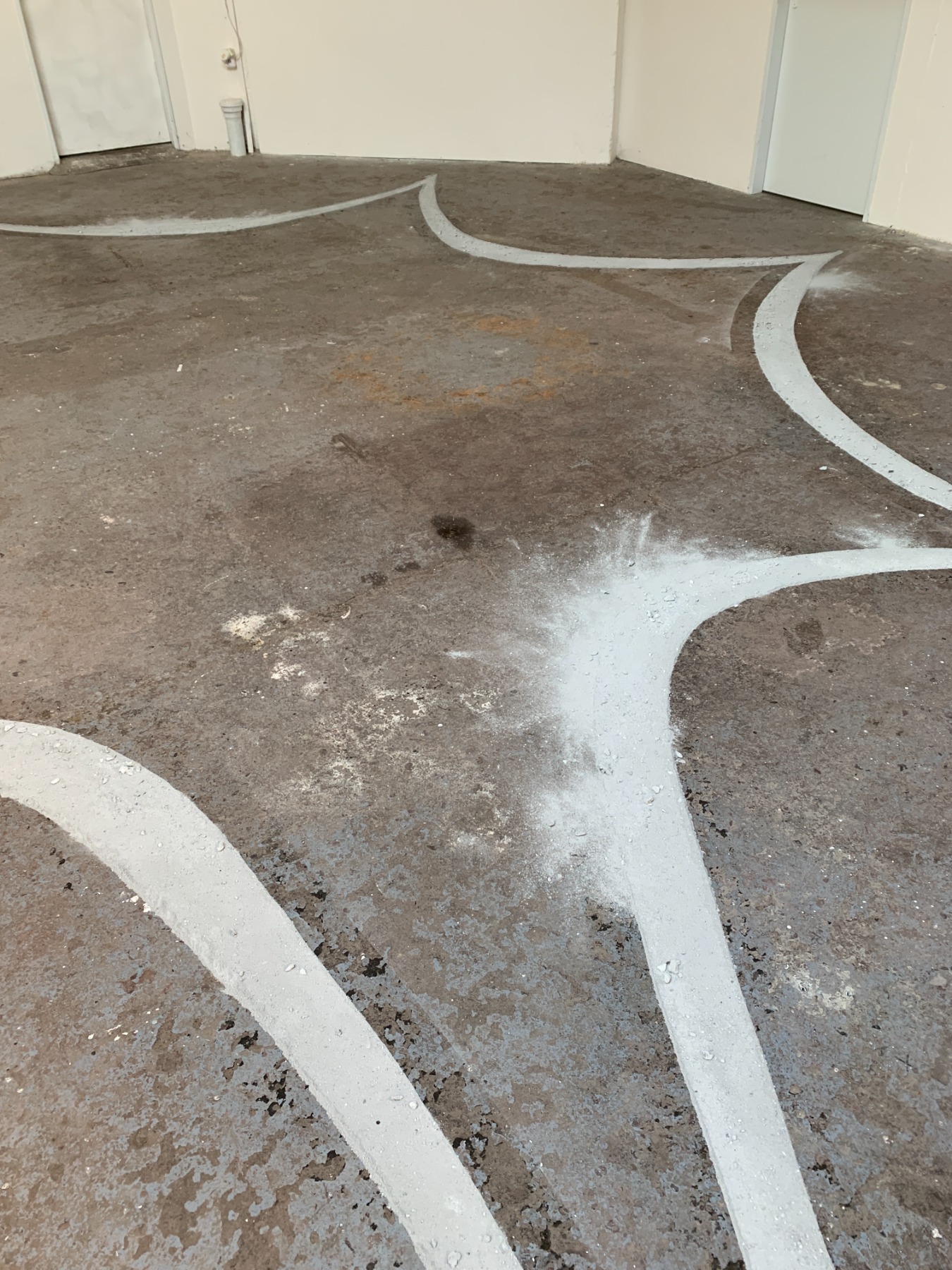
The material and what you depict with it definitely work together. For the upcoming show, you will also be making a soft sculpture out of fabric for the first time.
Regarding my art practice, it’s my first time, but when taking a break from my practice, I started sewing things. It felt natural to make plushies. It feels right to put this character that has followed me in my practice for the past few years into a three-dimensional form. It has grown on me so much that it had to become tangible.
Who is this character, actually? Who do they embody for you?
I wonder, too. Well, I feel like it came to me years ago, when I started making works about this feeling of apocalypse. I knew that I didn’t want my work to be didactic. Even though there is this sense of doom, it feels silly in a way. But I still saw all these very strong emotions around me at the time when I was making the first work. It was at the beginning of COVID, but even before that, I started thinking about this theme. I was looking for something that embodies all of these strong emotions in a hyperbolized way. Naturally, I created this cartoony character because cartoons, comics have such a good way to express emotions in silly ways. I like this cartoony aspect of how things can happen incorrectly if we're talking anatomically. And well, I don’t have to be so connected to reality. I can visualise such different emotions and feelings and yet keep a sense of humour. It's a serious topic, but it's not that serious, like, what can I do? The character lets me remind myself and the viewer that it’s not that serious.
‘END IS NIGH! II’, 2021, photo by the artist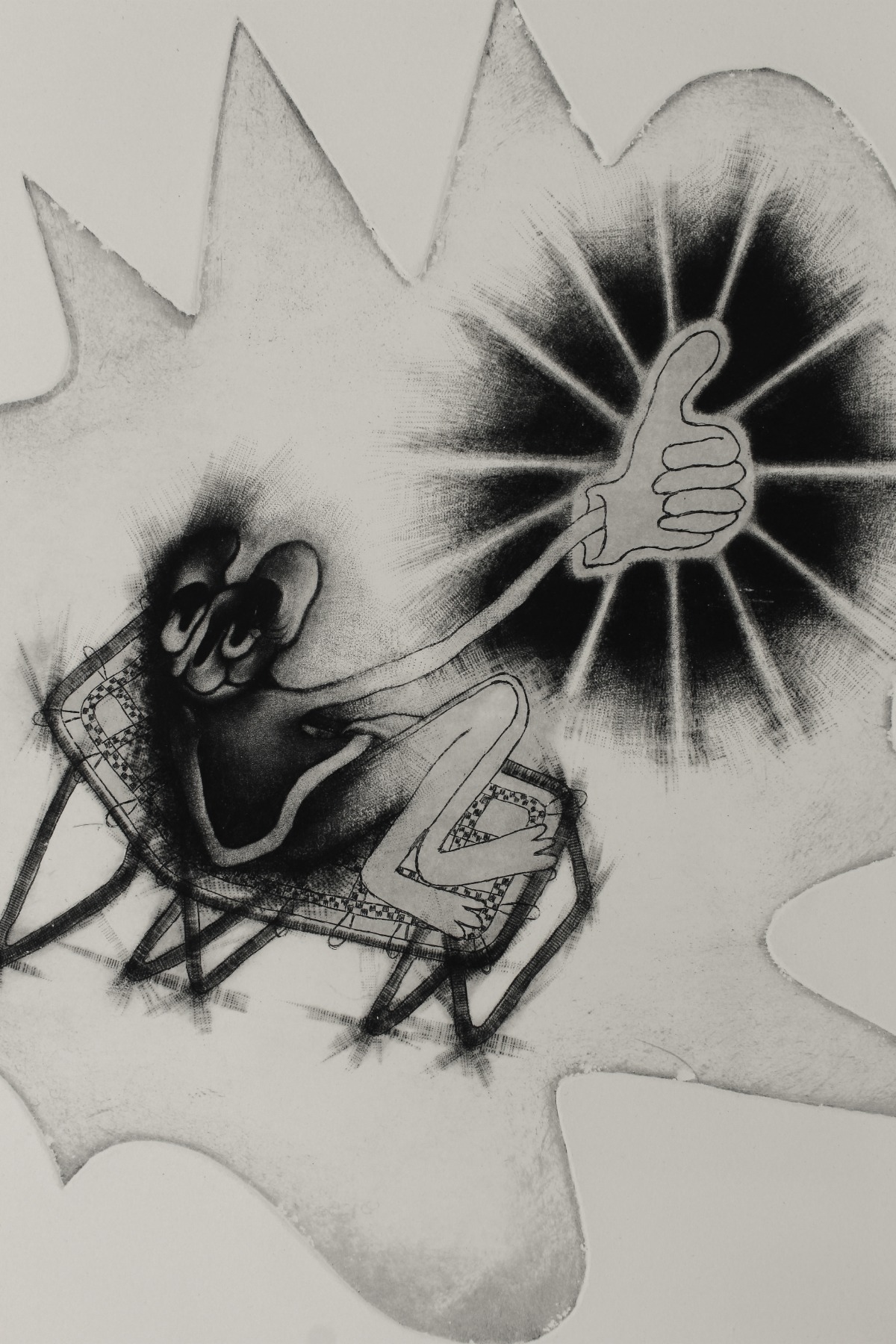
Humour is always a good tool when dealing with harsh realities. You’ll also create a mural in the space, like a door to maybe another place.
Right, that was the plan. I have this peephole, so it feels natural to have this nonexistent door. Everything is somehow there, but not really. It’s the idea of a door. Because I create this imaginary landscape that is inspired by the landscape of cemeteries, not very strictly but vaguely, there is this sense of what is behind that door, what is on the other side. I have no answer to that, but yeah, a door is quite symbolic.
It is quite symbolic, especially when I envision this door, people can peek through a keyhole, and on our side of the space there’s this green grass. That reminds me of the saying that the grass is always greener on the other side. Which would then be where we are in this space at that time.
That’s so true. I love what happens when putting together these works. I always have this underlying idea of knowing what it’s about. Through the work and when putting it together, it all connects in a way that I didn’t expect. I think that happens for artists.
Title image: Dzelde Mierkalne and ‘LOWKEY KATASTROFY FUNRIDE’, 2023. Photo: Roberts Svižeņecs